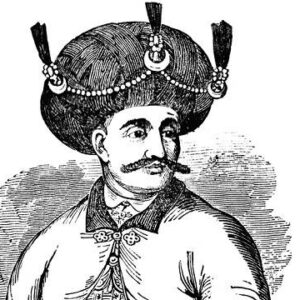In the mid-eighteenth century, Hyder Ali was the Muslim king of the Kingdom of Mysore in southern India. In the British attempts to acquire control of southern India, he proved to be the most formidable army they faced. Hyder Naik was born in Mysore and began his military career as a petty officer in the Mysore army, where he served on the nizam. The assassination of the nizam and the events that followed allowed the daring and ambitious Hyder Naik to gather military weapons from the government of Bombay (Mumbai) and organize his own army. He then proceeded to depose Mysore’s new ruler and declared himself the de facto ruler of the kingdom. During the First and Second Anglo–Mysore Wars, he was a brave warrior who passionately maintained his domains and opposed the British East India Company’s military advances. He formed an alliance with the French against the British and engaged Frenchmen to increase his artillery and arsenal. He was known for his administrative and military skills. He is also credited with introducing the iron-cased Mysorean rockets to the military. He was a clever leader who significantly extended the kingdom of Mysore, which he passed down to his son, Tipu Sultan.
Childhood and Adolescence
Hyder Ali is thought to have been born around 1720, while his actual date of birth is unknown. His early life is also shrouded in mystery. Budikote, Kolar, Karnataka, is his most likely birthplace. His father, Fath Muhammad, was a military officer in the Kingdom of Mysore’s Wodeyar Rajas’ service.
There are also some inconsistencies in his ancestry. According to some sources, his grandpa was derived from a line of Muslims who traced their ancestors back to Persia, while others believe he was born in what is now Afghanistan.
Reign & Accession of Hyder Ali
Hyder and his brother Shahbaz joined the military when their father died. Hyder began his career as a minor officer in the Mysore army, where he served on the nizam. Before relocating to Seringapatam, where Hyder’s uncle served, the brothers served for a period of years under the rulers of Arcot.
Hyder advanced fast through the military ranks and was soon in command of 100 cavalry and 2,000 soldiers under Shahbaz’s command. When the long-serving Nizam of Hyderabad, Qamar-ud-din Khan, Asaf Jah I, died in 1748, a severe succession fight ensued, during which Hyder rose to prominence as a military commander.
By 1755, he had risen to the rank of general, commanding 3,000 infantry and 1,500 cavalry. With the passage of time, he got more ambitious and deposed the ruler of Mysore, assuming control of the princely state himself.
He declared himself de facto monarch of the Kingdom of Mysore in 1761. He then went on to capture Bednore (now Haidarnagar), Kanara, and the southern Indian petty poligars (feudal chiefs).
He established the Sultanate of Mysore and assumed the title of Sultan Hyder Ali Khan. He subsequently launched a series of large-scale campaigns to expand his dominion. From the Marathas, he obtained Sira and the kingdom of Bednore. He now had authority over a number of ports, including Mangalore. He established a small navy using these ports.
By the 1760s, the British East India Company had surpassed the Dutch East India Company as the most powerful European colonial power on the Indian east coast. In 1767, the Sultanate of Mysore and the East India Company fought the First Anglo–Mysore War. After two years of bloody fighting, the British were obliged to sign the Treaty of Madras, a mutual defense treaty with Hyder, on March 29, 1769.
However, when Hyder Ali was fighting the Marathas in 1770, the British failed to uphold their word. Hyder, enraged by the British’s failure to help him, formed an alliance with the Marathas and the nizam to fight the British together.
In 1780, the Kingdom of Mysore and the British East India Company fought the Second Anglo–Mysore War. In this war, Hyder Ali also enlisted the help of the French against the British. In his early campaigns, he had considerable success, and as the war advanced, the British government tried to conclude the struggle with Mysore, and the war ended with the signing of the Treaty of Mangalore in 1784. Hyder, on the other hand, did not live to see the war come to a close.
Battles of Importance
Hyder Ali had some success against the British East India Company in the First Anglo–Mysore War (1767–1769), almost conquering Madras. The Treaty of Madras, which included a condition mandating the British to aid Hyder Ali if he was attacked by his neighbors, brought the conflict to a close.
The bloodshed in the Second Anglo–Mysore War (1780–1784) was significantly greater than in the first. Early on in his campaign, Hyder Ali had some success. During the conflict, his health deteriorated significantly, and he died in 1782. His successor, Tipu Sultan, maintained the conflict.
Personal History and Legacy
Hyder Ali’s personal life is shrouded in mystery. However, it is known that he had at least two marriages, and it is likely that he had more. Fakhr-un-nissa, his second wife, was the mother of his successor, Tipu.
Hyder Ali died on December 7, 1782, from a malignant tumor on his back.
Estimated Net Worth
The Estimated net worth of Hyder Ali is unknown.


